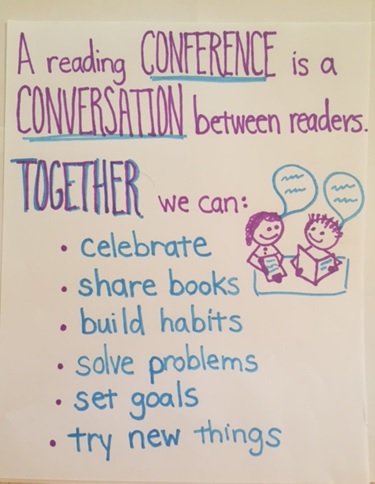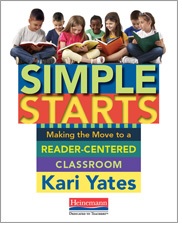This is a repost from earlier this year. Kari’s book, Simple Starts, has helped me and so many of the teachers I work with and so it’s absolutely worthy of repeating Kari’s thoughts here on TTYD. Thank you @Kari_Yates.
Heartfelt thanks to Kari Yates, author of Simple Starts for sharing in That Thing You Do! today. Kari is a program manager for literacy and English Learners supporting teachers and administrators in literacy instruction. You can follow Kari at her site SimplyInspiredTeaching.com and on Twitter @Kari_Yates.

Ah, the one-to-one reading conference. I know of no practice more joyful and powerful than pulling up alongside a reader.
How lucky we are to get to engage in these conversations day in and day out. We confer in order to:
- Share the joy of reading with our students.
- See for ourselves how reading is going for them.
- Support them in making adjustments that will result in more meaningful and vibrant reading lives.
At it’s best, the reading conference is a partnership between two readers, bathed in a sea of conversation.
But if we aren’t careful, the balance of power in these partnerships can get a bit lopsided. It’s easy to understand how this happens. We’re so used to taking charge, being directive and giving assignments that sometimes our conferences feel more like personalized pop quizzes or accountability checks, than a conversation between readers. Creating the feel of an honest partnership in our one-on-one conferences can take a bit of time and finesse,
So, today I offer five considerations for building robust conferring partnerships with our students.
Help students understand why and how we confer. For any partnership to thrive, both parties need to be informed and engaged. Imagine partnering with a coworker to plan for an upcoming presentation if only one of you really understood the desired outcomes for the project. True collaboration would be impossible.
This is exactly what sometimes happens to our students. Unknowingly, we forget to share the “inside scoop” about what we’re doing when we pull up alongside students with clipboard in hand. We plan and schedule and show up . We ask questions and jot notes and suggest possibilities. But we’ll never fully realize the potential of this vital practice if our students aren’t positioned to be active partners. Information is power. Kids want and need to understand things like:
- why we confer in the first place
- what they can expect in a conference
- how they might prepare or contribute
Consider the anchor chart included with this post for a moment. What kind of explicit teaching, modeling, and engagement might this chart inspire? How might you engage your students in a whole group learning experience that prepares them to be more equal conferring partners?
Approach the conference with the actions, gestures, and words of a partner. First impressions matter. So, rather than “call students up” to a the teacher’s desk or table or hover above them at their desks, we physically go to our students wherever they are. When we arrive, we sit or squat or kneel so that we are at their level. This simple act of meeting them wherever they are communicates from the beginning, “We’re partners.”
The first few moments of the conference are crucial. So, we smile. We knock gently at the door, asking permission to interrupt their precious independent reading time. We use a voice that is kind and inviting, leaving our “I’m in charge of this classroom” hat at the door. Throughout the conference our words and our actions show that we are readers, too. We share the joys of being a reader and we are empathetic to the struggles that readers sometimes face. We’re here to partner toward success.
Empower students to actively plan for conferences. We’re likely already teaching students to jot notes on stickies or in their response journal as they read. So, suggesting that sometimes they might make a special note about something they want to be sure we talk about in conference is an easy extension of this work. In a crowded classroom, knowing that you’ll not only have the opportunity to have the teacher to yourself, but that you can be the one to drive the agenda has to feel incredibly empowering, don’t you think?
If we can get into the habit of starting each conference by inviting students to share what’s been on their minds, we give them the strong message that we value their thoughts and that their topics are worthy of our shared time.
Do more wondering than telling, and more listening than talking. Although we may sometimes teach in a conference, more important is the fact that every conference is an opportunity to listen and learn about the reader beside us. To set ourselves up for as much learning as possible, we’ll want to brush off our best open-ended questions, creating a bit of an inquiry into the life of this student. s a follow-up to worthwhile questions, we’ll want to listen more and talk less. To do this, of course means having to tolerate some waittime. How might we build our own stamina for allowing student processing time?
Bring joy to every conference. This precious time with one precious learner in the world of books should be a truly joyful time. But sadly, for some students, having one-on-one time with the teacher can be quite anxiety producing, especially in the beginning. Their trust is low. Their interactions with adults in the past have not been so positive. Some assume a private conversation with the teacher means they’re in trouble or have done something wrong. So, we must tread gently and bring our warmest selves. We must polish up our admiring lens (Goldberg, 2016) and be determined to see the good in each and every reader. We must notice what’s working, name it, and encourage more of it. We must smile and laugh and celebrate as much as we are able. We must make the reading conference a time and place that every child cherishes and looks forward to.
Time building partnerships with students is time well spent. When we set students up as true partners in learning, a bit of magic starts to happen. We gain their trust. They open up to us. They share how things are really going. They engage more actively in problem solving, They allow themselves to take more risks. And as a result the learning goes deeper and the relationship grows stronger.
I know no practice more joyful and powerful than pulling up alongside a reader.
To discover more ways to nurture independent reading lives,check out my book Simple Starts: Making the Move to a Reader-Centered Classroom, Heinemann 2015.
–Kari Yates











